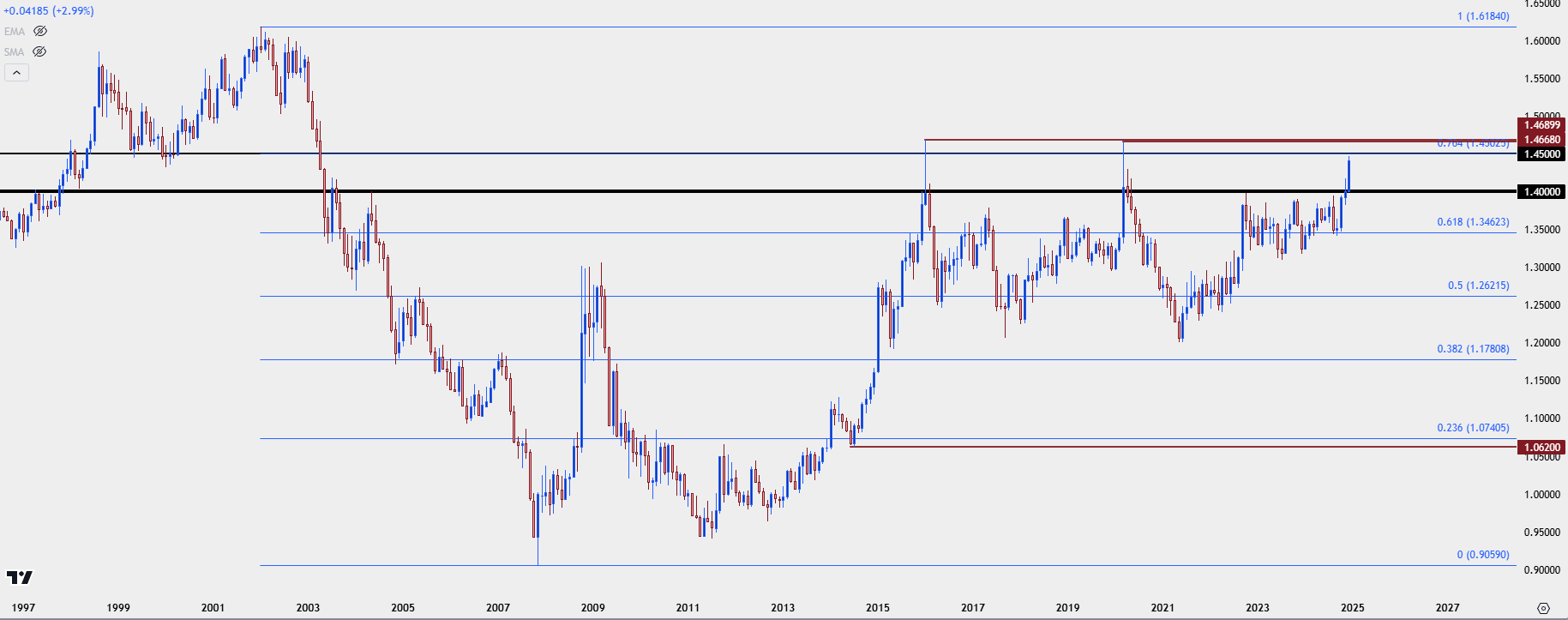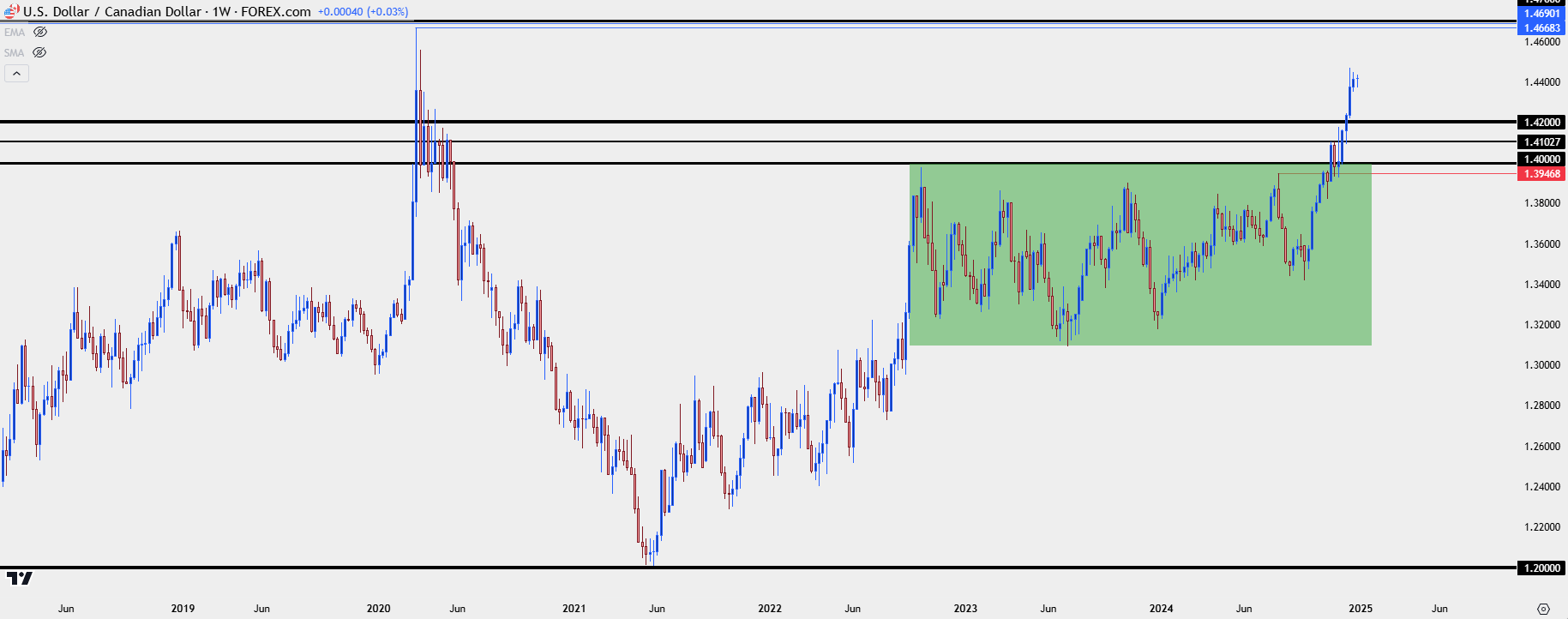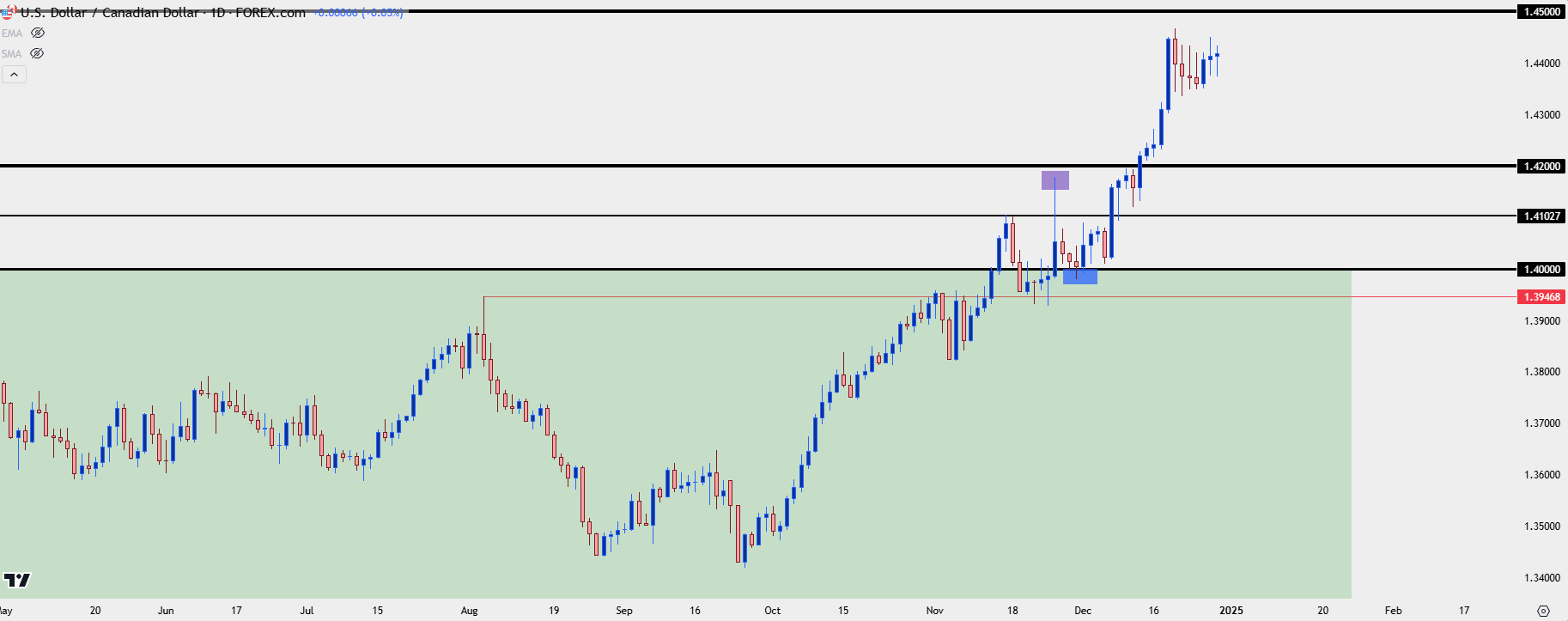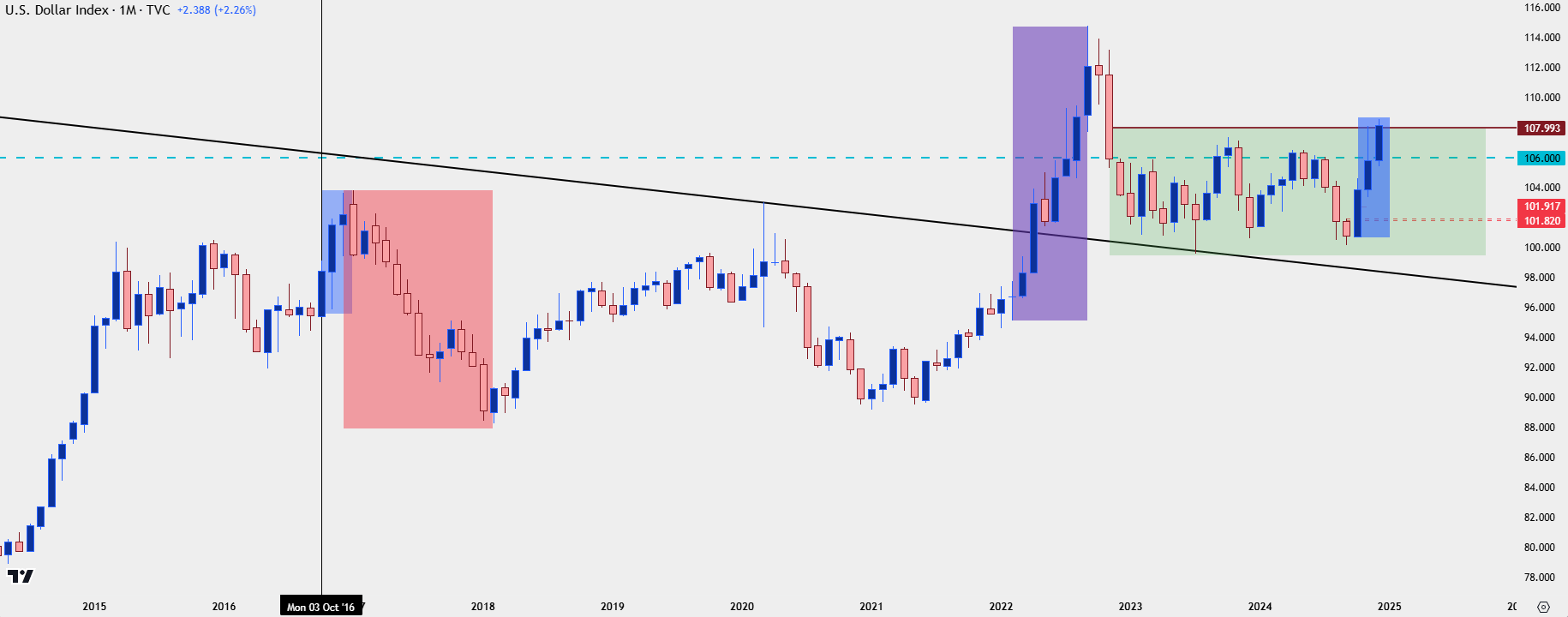
USD/CAD, Canadian Dollar Talking Points:
- USD/CAD is nearing its first yearly close above 1.4000 since 2002.
- The USD/CAD pair has been mean-reverting for much of the past decade, and there have been two separate instances of tests above the 1.4500 level which have both led to reversals.
- In the most recent episode, it’s the prospect of tariffs on Canadian imports to the U.S. which brings a large threat to the Canadian economy. But it remains to be seen whether this is a negotiating tactic from President-elect Trump or whether massive change is to follow in U.S.-Canadian economic relations post-inauguration.
USD/CAD is currently up by 8.66% on the year, which would be the largest yearly gain for the pair since 2015. Much of the recent rally was concentrated in the 4th quarter, after the election; but making matters more interesting is the fact that the 2015 move was driven by the Fed’s first rate hike since the Financial Collapse as markets spent the year bracing for the move. And in direct contrast the 2024 episode took place even as the Fed kicked off a cutting cycle.
Of course, there’s an obvious driver at-play following the second election of Donald Trump and there’s been numerous headlines about possible tariffs to be imposed on Canada. The initial volley was a possible 25% tariff on Canada if the northern border to the United States wasn’t shored up. This was followed by Prime Minister Trudeau making a trip down to Florida to appeal to the President-elect, highlighting the fact that there’s stark contrast between the flow of migrants and drugs between the northern and southern borders.
Since then, however, it’s seemed to be a bit more jovial with Trump taking on a more-playful tone by calling Canada the 51st U.S. state and Prime Minster Trudeau a ‘governor.’ Given that, it would be simple to ascribe Trump’s initial threat of tariffs as a negotiation tactic by as we heard from BoC Governor Tiff Macklem at the bank’s December rate cut, it introduces an element of uncertainty and that’s something the markets generally abhor. Accordingly, we’ve seen the Canadian currency punished against the US Dollar as the pair is nearing its first yearly close above the 1.4000 handle since 2002.
USD/CAD Monthly Price Chart
 Chart prepared by James Stanley, USD/CAD on Tradingview
Chart prepared by James Stanley, USD/CAD on Tradingview
USD/CAD History at 1.4000
In the wake of the Financial Collapse the Fed seemed to have very little drive to normalize rates. And with US rates holding near-zero, there was practically little reason for investors to seek out the currency, instead pushing towards riskier alternatives. But through 2014 the door began to slightly open for an eventual move of higher rates from the Fed and in 2015, the bank continued to guide the market in that direction, eventually hiking for the first time since the Financial Collapse in December of that year.
That helped to drive a rally in USD/CAD from a 2014 low of 1.0620 to a January 2016 high of 1.4689.
But as the Fed hiked it became clear that the policy of normalization wasn’t going to unsettle monetary policy at the world’s largest Central Bank, and the Fed would continue to move-forward carefully. That helped to push bulls back into a pattern of mean reversion and that’s what’s largely held for the pair since.
There was the 2020 episode around Covid, when risk aversion drove a strong rally in the US Dollar but that run stalled 22 pips inside of the 2016 high before mean reversion showed up again. And since then, bulls didn’t even show an interest in testing above the 1.4000 handle as there was an even tighter range developing over the past two years.
But it was the move in Q4 of 2024 that started to show a change-of-pace.
USD/CAD Weekly Chart
 Chart prepared by James Stanley, USD/CAD on Tradingview
Chart prepared by James Stanley, USD/CAD on Tradingview
USD/CAD Rally: A Confluence of Factors
Coming into Q4 of 2024 the US Dollar was incredibly weak. The currency had just spent the month of September with varying stages of oversold conditions, and this was as the Fed started a rate cutting cycle with a ‘jumbo’ move of 50 bps.
But – interestingly it was around that rate cut that the move had started to show symptoms of stall, and there was a building backdrop for reversal potential that started to play out shortly after the Q4 open. DXY had built a falling wedge formation, often approached with aim of bullish reversal; and RSI had diverged for the better part of the final few weeks of Q3 trade.
USD/CAD tracked that USD and DXY rally quite well, and both markets caught another shot-in-the-arm after the US election, which finally propelled USD/CAD above 1.4000 for the first time in four years.
But it was what happened on Tuesday, November 26th that really started to drive the matter, and that was when President-elect Trump first opined on the prospect of 25% tariffs on Canadian goods unless they clamped down on the northern border. That drove a spike in the pair’s price (highlighted by purple box on the below chart), which soon reversed – but after that reversal there started to show support at the 1.4000 handle and buyers continued to show-up. Bulls went to work again after the NFP report in early-December, and USD/CAD price action continued to spiral-higher through the FOMC rate decision a couple of weeks later.
USD/CAD Daily Chart
 Chart prepared by James Stanley, USD/CAD on Tradingview
Chart prepared by James Stanley, USD/CAD on Tradingview
USD/CAD into 2025
I think that it’s notable that Tiff Macklem noted the uncertainty around possible tariffs at the December rate cut. I also think that’s something that helped to drive the trend in USD/CAD, with overbought readings eventually reaching above the 80 level on Daily RSI.
So, while the initial move in USD/CAD very much tracks the broader move in the US Dollar, it was the addition of tariff threats that propelled the pair above the 1.4000 level that buyers were previously hesitant to test, also driving RSI to very overbought readings in December.
But perhaps the larger question when looking ahead is whether Trump policies would rather push stock market gains or a stronger U.S. Dollar, and for that we can look back to his prior election in 2016 for guidance.
In that instance, much like we saw in 2024, the initial reaction was strength in both the USD and US equities. But it was shortly after the 2017 open that Trump began to opine on the strong U.S. Dollar, commenting that “I think our dollar is getting too strong, and partially that’s my fault because people have confidence in me.”
This is discussed in an article on CBSNews.com, titled ‘Trump says the dollar is “too strong” – good luck weakening it.”
Well in the year of 2017, USD weakness was very much the name of the game, even as the Federal Reserve hiked rates three times that year, standing in stark contrast to the two hikes the bank had imposed in the prior nine years.
On the below monthly chart of the USD, we can see the Trump-driven rally in Q4 of 2016 leading into the massive sell-off of 2017, even with the FOMC tightening rates by 75 bps.
While the sample size here is small, it’s also notable that President-elect Trump has previously said that he loves debt, and it begs the question as to whether he’d back a campaign of fiscal austerity, which would serve push the US Dollar higher and, in-turn, stock prices-lower. A rampantly strong U.S. Dollar is unlikely to be a positive for stocks such as we saw in 2022 (the purple box on the below chart).
And if we do see the USD go back into a pattern of mean reversion, which could couple a backing-off of tariff threats from President Trump, then mean-reversion theme can soon look attractive again in the USD/CAD pair.
US Dollar Monthly Chart
 Chart prepared by James Stanley; data derived from Tradingview
Chart prepared by James Stanley; data derived from Tradingview
--- written by James Stanley, Senior Strategist





